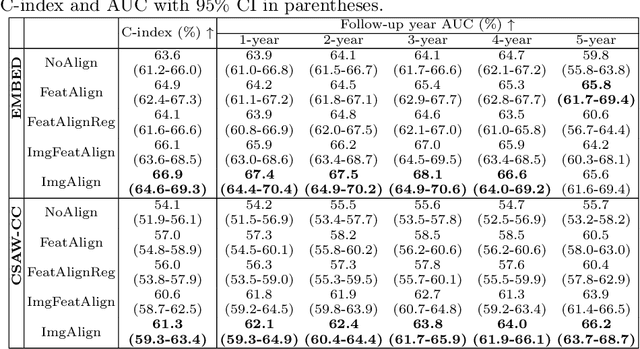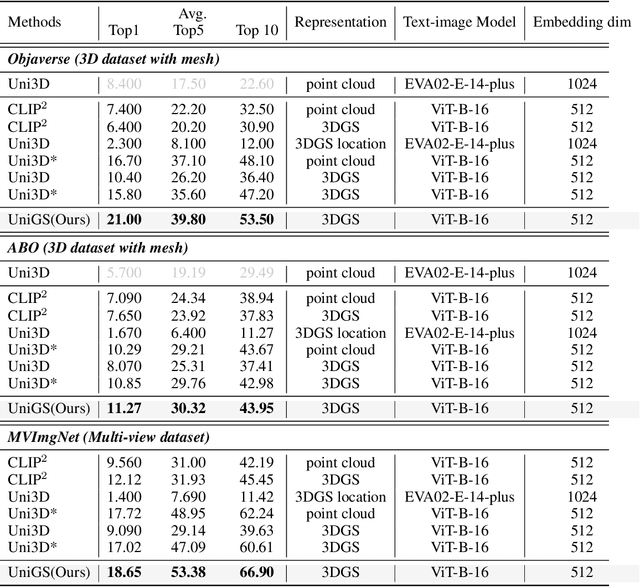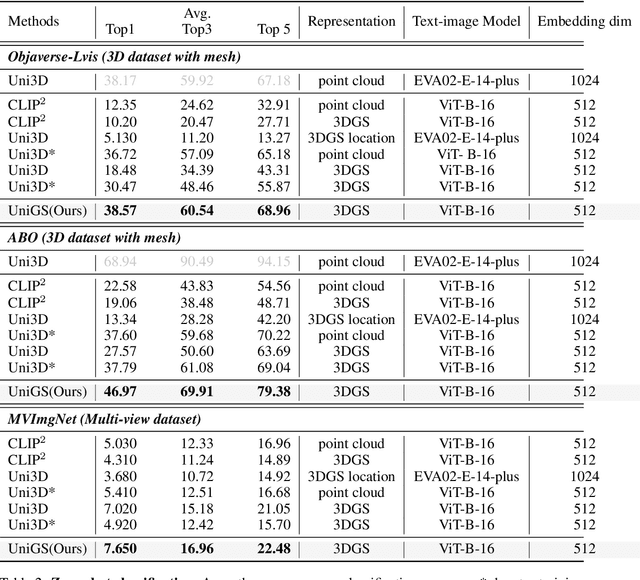Michael Kampffmeyer
UiT The Arctic University of Norway, Norwegian Computing Center
ProPy: Building Interactive Prompt Pyramids upon CLIP for Partially Relevant Video Retrieval
Aug 26, 2025Abstract:Partially Relevant Video Retrieval (PRVR) is a practical yet challenging task that involves retrieving videos based on queries relevant to only specific segments. While existing works follow the paradigm of developing models to process unimodal features, powerful pretrained vision-language models like CLIP remain underexplored in this field. To bridge this gap, we propose ProPy, a model with systematic architectural adaption of CLIP specifically designed for PRVR. Drawing insights from the semantic relevance of multi-granularity events, ProPy introduces two key innovations: (1) A Prompt Pyramid structure that organizes event prompts to capture semantics at multiple granularity levels, and (2) An Ancestor-Descendant Interaction Mechanism built on the pyramid that enables dynamic semantic interaction among events. With these designs, ProPy achieves SOTA performance on three public datasets, outperforming previous models by significant margins. Code is available at https://github.com/BUAAPY/ProPy.
A robust and versatile deep learning model for prediction of the arterial input function in dynamic small animal $\left[^{18}\text{F}\right]$FDG PET imaging
Jul 03, 2025Abstract:Dynamic positron emission tomography (PET) and kinetic modeling are pivotal in advancing tracer development research in small animal studies. Accurate kinetic modeling requires precise input function estimation, traditionally achieved via arterial blood sampling. However, arterial cannulation in small animals like mice, involves intricate, time-consuming, and terminal procedures, precluding longitudinal studies. This work proposes a non-invasive, fully convolutional deep learning-based approach (FC-DLIF) to predict input functions directly from PET imaging, potentially eliminating the need for blood sampling in dynamic small-animal PET. The proposed FC-DLIF model includes a spatial feature extractor acting on the volumetric time frames of the PET sequence, extracting spatial features. These are subsequently further processed in a temporal feature extractor that predicts the arterial input function. The proposed approach is trained and evaluated using images and arterial blood curves from [$^{18}$F]FDG data using cross validation. Further, the model applicability is evaluated on imaging data and arterial blood curves collected using two additional radiotracers ([$^{18}$F]FDOPA, and [$^{68}$Ga]PSMA). The model was further evaluated on data truncated and shifted in time, to simulate shorter, and shifted, PET scans. The proposed FC-DLIF model reliably predicts the arterial input function with respect to mean squared error and correlation. Furthermore, the FC-DLIF model is able to predict the arterial input function even from truncated and shifted samples. The model fails to predict the AIF from samples collected using different radiotracers, as these are not represented in the training data. Our deep learning-based input function offers a non-invasive and reliable alternative to arterial blood sampling, proving robust and flexible to temporal shifts and different scan durations.
Reconsidering Explicit Longitudinal Mammography Alignment for Enhanced Breast Cancer Risk Prediction
Jun 24, 2025



Abstract:Regular mammography screening is essential for early breast cancer detection. Deep learning-based risk prediction methods have sparked interest to adjust screening intervals for high-risk groups. While early methods focused only on current mammograms, recent approaches leverage the temporal aspect of screenings to track breast tissue changes over time, requiring spatial alignment across different time points. Two main strategies for this have emerged: explicit feature alignment through deformable registration and implicit learned alignment using techniques like transformers, with the former providing more control. However, the optimal approach for explicit alignment in mammography remains underexplored. In this study, we provide insights into where explicit alignment should occur (input space vs. representation space) and if alignment and risk prediction should be jointly optimized. We demonstrate that jointly learning explicit alignment in representation space while optimizing risk estimation performance, as done in the current state-of-the-art approach, results in a trade-off between alignment quality and predictive performance and show that image-level alignment is superior to representation-level alignment, leading to better deformation field quality and enhanced risk prediction accuracy. The code is available at https://github.com/sot176/Longitudinal_Mammogram_Alignment.git.
DiffFuSR: Super-Resolution of all Sentinel-2 Multispectral Bands using Diffusion Models
Jun 13, 2025Abstract:This paper presents DiffFuSR, a modular pipeline for super-resolving all 12 spectral bands of Sentinel-2 Level-2A imagery to a unified ground sampling distance (GSD) of 2.5 meters. The pipeline comprises two stages: (i) a diffusion-based super-resolution (SR) model trained on high-resolution RGB imagery from the NAIP and WorldStrat datasets, harmonized to simulate Sentinel-2 characteristics; and (ii) a learned fusion network that upscales the remaining multispectral bands using the super-resolved RGB image as a spatial prior. We introduce a robust degradation model and contrastive degradation encoder to support blind SR. Extensive evaluations of the proposed SR pipeline on the OpenSR benchmark demonstrate that the proposed method outperforms current SOTA baselines in terms of reflectance fidelity, spectral consistency, spatial alignment, and hallucination suppression. Furthermore, the fusion network significantly outperforms classical pansharpening approaches, enabling accurate enhancement of Sentinel-2's 20 m and 60 m bands. This study underscores the power of harmonized learning with generative priors and fusion strategies to create a modular framework for Sentinel-2 SR. Our code and models can be found at https://github.com/NorskRegnesentral/DiffFuSR.
Optimizing Data Augmentation through Bayesian Model Selection
May 27, 2025Abstract:Data Augmentation (DA) has become an essential tool to improve robustness and generalization of modern machine learning. However, when deciding on DA strategies it is critical to choose parameters carefully, and this can be a daunting task which is traditionally left to trial-and-error or expensive optimization based on validation performance. In this paper, we counter these limitations by proposing a novel framework for optimizing DA. In particular, we take a probabilistic view of DA, which leads to the interpretation of augmentation parameters as model (hyper)-parameters, and the optimization of the marginal likelihood with respect to these parameters as a Bayesian model selection problem. Due to its intractability, we derive a tractable Evidence Lower BOund (ELBO), which allows us to optimize augmentation parameters jointly with model parameters. We provide extensive theoretical results on variational approximation quality, generalization guarantees, invariance properties, and connections to empirical Bayes. Through experiments on computer vision tasks, we show that our approach improves calibration and yields robust performance over fixed or no augmentation. Our work provides a rigorous foundation for optimizing DA through Bayesian principles with significant potential for robust machine learning.
Aggregation of Dependent Expert Distributions in Multimodal Variational Autoencoders
May 02, 2025Abstract:Multimodal learning with variational autoencoders (VAEs) requires estimating joint distributions to evaluate the evidence lower bound (ELBO). Current methods, the product and mixture of experts, aggregate single-modality distributions assuming independence for simplicity, which is an overoptimistic assumption. This research introduces a novel methodology for aggregating single-modality distributions by exploiting the principle of consensus of dependent experts (CoDE), which circumvents the aforementioned assumption. Utilizing the CoDE method, we propose a novel ELBO that approximates the joint likelihood of the multimodal data by learning the contribution of each subset of modalities. The resulting CoDE-VAE model demonstrates better performance in terms of balancing the trade-off between generative coherence and generative quality, as well as generating more precise log-likelihood estimations. CoDE-VAE further minimizes the generative quality gap as the number of modalities increases. In certain cases, it reaches a generative quality similar to that of unimodal VAEs, which is a desirable property that is lacking in most current methods. Finally, the classification accuracy achieved by CoDE-VAE is comparable to that of state-of-the-art multimodal VAE models.
UniGS: Unified Language-Image-3D Pretraining with Gaussian Splatting
Feb 25, 2025



Abstract:Recent advancements in multi-modal 3D pre-training methods have shown promising efficacy in learning joint representations of text, images, and point clouds. However, adopting point clouds as 3D representation fails to fully capture the intricacies of the 3D world and exhibits a noticeable gap between the discrete points and the dense 2D pixels of images. To tackle this issue, we propose UniGS, integrating 3D Gaussian Splatting (3DGS) into multi-modal pre-training to enhance the 3D representation. We first rely on the 3DGS representation to model the 3D world as a collection of 3D Gaussians with color and opacity, incorporating all the information of the 3D scene while establishing a strong connection with 2D images. Then, to achieve Language-Image-3D pertaining, UniGS starts with a pre-trained vision-language model to establish a shared visual and textual space through extensive real-world image-text pairs. Subsequently, UniGS employs a 3D encoder to align the optimized 3DGS with the Language-Image representations to learn unified multi-modal representations. To facilitate the extraction of global explicit 3D features by the 3D encoder and achieve better cross-modal alignment, we additionally introduce a novel Gaussian-Aware Guidance module that guides the learning of fine-grained representations of the 3D domain. Through extensive experiments across the Objaverse, ABO, MVImgNet and SUN RGBD datasets with zero-shot classification, text-driven retrieval and open-world understanding tasks, we demonstrate the effectiveness of UniGS in learning a more general and stronger aligned multi-modal representation. Specifically, UniGS achieves leading results across different 3D tasks with remarkable improvements over previous SOTA, Uni3D, including on zero-shot classification (+9.36%), text-driven retrieval (+4.3%) and open-world understanding (+7.92%).
Robust Classification by Coupling Data Mollification with Label Smoothing
Jun 03, 2024



Abstract:Introducing training-time augmentations is a key technique to enhance generalization and prepare deep neural networks against test-time corruptions. Inspired by the success of generative diffusion models, we propose a novel approach coupling data augmentation, in the form of image noising and blurring, with label smoothing to align predicted label confidences with image degradation. The method is simple to implement, introduces negligible overheads, and can be combined with existing augmentations. We demonstrate improved robustness and uncertainty quantification on the corrupted image benchmarks of the CIFAR and TinyImageNet datasets.
MMTryon: Multi-Modal Multi-Reference Control for High-Quality Fashion Generation
May 01, 2024



Abstract:This paper introduces MMTryon, a multi-modal multi-reference VIrtual Try-ON (VITON) framework, which can generate high-quality compositional try-on results by taking as inputs a text instruction and multiple garment images. Our MMTryon mainly addresses two problems overlooked in prior literature: 1) Support of multiple try-on items and dressing styleExisting methods are commonly designed for single-item try-on tasks (e.g., upper/lower garments, dresses) and fall short on customizing dressing styles (e.g., zipped/unzipped, tuck-in/tuck-out, etc.) 2) Segmentation Dependency. They further heavily rely on category-specific segmentation models to identify the replacement regions, with segmentation errors directly leading to significant artifacts in the try-on results. For the first issue, our MMTryon introduces a novel multi-modality and multi-reference attention mechanism to combine the garment information from reference images and dressing-style information from text instructions. Besides, to remove the segmentation dependency, MMTryon uses a parsing-free garment encoder and leverages a novel scalable data generation pipeline to convert existing VITON datasets to a form that allows MMTryon to be trained without requiring any explicit segmentation. Extensive experiments on high-resolution benchmarks and in-the-wild test sets demonstrate MMTryon's superiority over existing SOTA methods both qualitatively and quantitatively. Besides, MMTryon's impressive performance on multi-items and style-controllable virtual try-on scenarios and its ability to try on any outfit in a large variety of scenarios from any source image, opens up a new avenue for future investigation in the fashion community.
ExMap: Leveraging Explainability Heatmaps for Unsupervised Group Robustness to Spurious Correlations
Mar 20, 2024



Abstract:Group robustness strategies aim to mitigate learned biases in deep learning models that arise from spurious correlations present in their training datasets. However, most existing methods rely on the access to the label distribution of the groups, which is time-consuming and expensive to obtain. As a result, unsupervised group robustness strategies are sought. Based on the insight that a trained model's classification strategies can be inferred accurately based on explainability heatmaps, we introduce ExMap, an unsupervised two stage mechanism designed to enhance group robustness in traditional classifiers. ExMap utilizes a clustering module to infer pseudo-labels based on a model's explainability heatmaps, which are then used during training in lieu of actual labels. Our empirical studies validate the efficacy of ExMap - We demonstrate that it bridges the performance gap with its supervised counterparts and outperforms existing partially supervised and unsupervised methods. Additionally, ExMap can be seamlessly integrated with existing group robustness learning strategies. Finally, we demonstrate its potential in tackling the emerging issue of multiple shortcut mitigation\footnote{Code available at \url{https://github.com/rwchakra/exmap}}.
 Add to Chrome
Add to Chrome Add to Firefox
Add to Firefox Add to Edge
Add to Edge